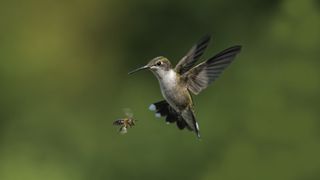Explained Lyrics Again and Again by Bird and Bee
"The birds and the bees." Significant and origin of the phrase

The phrase "the birds and the bees" is a term used to explain the mechanics of reproduction to younger children, relying on the imagery of bees pollinating and eggs hatching to substitute for a more technical explanation of sexual intercourse. It is a way of deflecting the inevitable question that every parent dreads: "Where do babies come from?" and it is an alternative to the explanation that the stork delivers babies.
It is uncertain when the phrase was first used or how it gained popularity. It does non necessarily hateful that parents are explaining how birds and bees reproduce. The connection between human sexuality and eggs and pollination is vague, which tin cause some confusion amid curious children.
Though there are some variations, the story typically involves bees pollinating flowers, symbolizing male fertilization, and the birds laying eggs, which equates to female ovulation. In another telling of the story, a babe is created when a bee stings a bird.
Literary and musical references
There are quite a few allusions to the phrase in literature and song. One of the early references to this bird and bees as a euphemism for reproduction is Samuel Taylor Coleridge's 1825 poem, "Work Without Hope":
"All Nature seems at work. Slugs get out their lair —
The bees are stirring — birds are on the wing —
And Winter, slumbering in the open air,
Wears on his smile face a dream of Spring!
And I, the while, the sole unbusy matter,
Nor love make, nor pair, nor build, nor sing."
Another normally cited employ of the phrase is American naturalist John Burroughs' 1875 fix of essays, "Birds and Bees, Sharp Eyes and other Papers." These were attempts to provide children with simple explanations of nature, but there is no try at sex pedagogy.
Dr. Emma Frances Angell Drake described the birds and bees in a section of the publication "The Story of Life," which was widely distributed between 1893 and 1930. In her explanation of reproduction to her young daughters, she used images of blue eggs in the robin'due south nest, the wind blowing pollen grit from one plant to the other, and bees gathering honey from the flowers.
A more direct reference tin be establish in Cole Porter's lyrics to the 1928 vocal "Let's Exercise It."
"Information technology is nature, that's all
Just telling us to fall in love
And that'southward why birds do it, bees practise it
Fifty-fifty educated fleas do it
Permit's practise it, allow's fall in honey"
The phrase too appeared in a 1939 outcome of the "Freeport Journal Standard": "A Frenchman was born sophisticated: he knows about the birds and the bees. In consequence, French films are made on a footing of creative understanding that does not hamper the story."
A more modern reference to the phrase occurred on "The Simpsons." episode Homer vs. Patty and Selma, first broadcast in 1995, according to Phrases.org.u.k.. The episode includes a scene has 10-yr-old Bart Simpson remarking to his friend Milhouse, "The Sun is out, birds are singing, bees are trying to have sex with them — equally is my understanding ..."
Additional resources
Read more than virtually the history of the phrase "the birds and the bees" with this article from Earth Histories. Explore an historic period-by-age guide to instruction kids nigh the birds and the bees with this informative article from Family Education. Bank check out five of the best books for explaining the birds and the bees with this article from Maternity & Baby Family.
Bibliography
- Kathleen Kelleher, Los Angeles Times, " Birds Do It, Bees Do Information technology, only Why'd We Say That?". 2000.
- Gary Martin, Phrase Finder "The birds and the bees", Phrases.org.britain.
- Burroughs, John. Birds and Bees: Precipitous Eyes, and Other Papers. Vol. ane. Houghton, Mifflin and Visitor, 1887.
- Davidson, Graham. "Coleridge:" work without hope". The Wordsworth Circumvolve 45.1 (2014): 21-29.
- Amy Lang's Birds and Bees and Kids. Tips and tools to start the sexual activity talks.
Source: https://www.livescience.com/39316-birds-and-the-bees.html
0 Response to "Explained Lyrics Again and Again by Bird and Bee"
Post a Comment